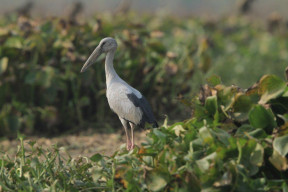Keshopur Miani Community Reserve Wetland
Introduction
Keshopur-Miani Community Reserve is located in State of Punjab, North West India. The community reserve lies in the district Gurdaspur at a distance of 7 Km from Gurdaspur township which is also the administrative headquarters of the district. This community reserve is spread in villages Dalla, Miani, Matwa, Dhalla and Magarmudhian that are located along the road connecting the Gurdaspur township and Behrampur village near the Indo-Pakistan border. The Keshopur-Miani Community Reserve lies in the former flood plains of the Rivers Ravi and Beas. It consists of a mosaic of natural marshes, aquaculture ponds and agricultural wetlands where crops such lotus and chestnut are cultivated. These wetlands are sustained by rainfall (Average annual rainfall - 959 mm). The wetlands are surrounded by rice, wheat and sugarcane fields. The area was declared as community reserve in 2007 primarily for its biodiversity. It is the only habitat for sarus and common cranes in Punjab and hosts large number of resident and migratory birds both during summer and winter season. The wetlands lie on the Central Asian Flyway. The management committee (Community Reserve Committee) of Keshopur-Miani Community Reserve has restricted conversation of wetland land use. The population from surrounding villages are dependent on the wetland for their livelihood. Keshopur-Miani Community Reserve cum wetland regularly supports more than 20,000 waterbirds. The waterbird population census conducted during last three years (2017-2019) indicates that the number of waterbirds ranged between 21,040 and 23,018. Keshopur-Miani Community Reserve supports the resident and migratory populations of vulnerable species of birds - sarus crane (Antigone antigone), common pochard (Aythya farina), woolly-necked stork (Ciconia episcopus) and greater spotted eagle (Clanga clanga) [Vulnerable - 4]. The terrain of Keshopur is largely plain and flat land. It varies in climate between subtropical, semi-arid and monsoonal. There are four distinct seasons in the area. The spring season extends from February to March, summer season extends from April to June, monsoon season extends from July to September and the winter season from October to January. It receives water from rains, surface runoff and is filled with water throughout the year.
Location
: District Pathankot
Access
: Gurdaspur – Behrampur Road and Gurdaspur-Gahlari Road
Latitude
: 32˚05’ 16˚3’ N
Longitude
: 75˚24’ 24˚2’ E
Altitude
: 245m
Notification Detail
Flora
: Keshopur wetland has a rich variety of flora with 344 species of plants recorded in the area. Major varieties are herbs (175), grasses (54), trees (48) and climbers (26). Herbs and grasses constitute 2/3 total floral species.
Fauna
: The fauna in the cultivated ponds includes a variety of invertebrates, amphibians, reptiles, birds, mammals. The faunal diversity in the natural marshes include 16 species of mammals, 434 species of migratory and resident birds and 27 species of fishes. The wetland is an important corridor that facilitates movement of animals like Axis porcinus, Manis crassicaudata and Sus scrofa.
Reach Us
Images

×
Historical Importance
--
Sandpiper at Keshopur Community Reserve



Coots at Keshopur Community Reserve

Sarus Crane at Keshopur Community Reserve









